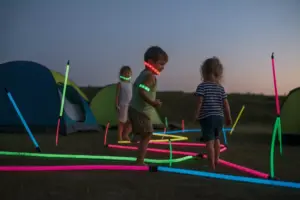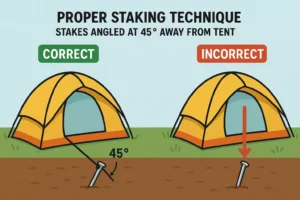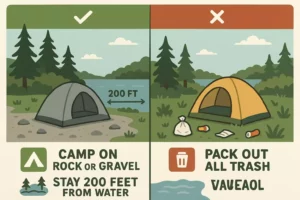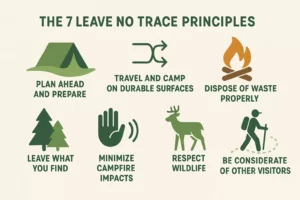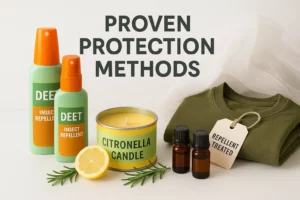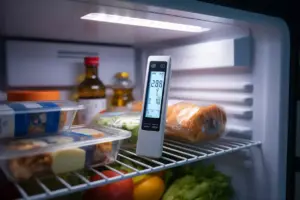How To Purify Water For Drinking Camping: Essential Methods for Safe Hydration in the Wilderness
When you’re miles from civilization with empty water bottles and a questionable stream as your only source, knowing how to purify water can literally save your life. Contaminated water causes over 3.4 million deaths annually worldwide, making water purification one of the most critical survival skills every camper must master.

Whether you’re planning a weekend camping trip or embarking on an extended wilderness adventure, access to clean drinking water should never be left to chance. Natural water sources often harbor dangerous bacteria, viruses, parasites, and chemical contaminants that can cause severe illness or worse.
Key Takeaways
- Boiling water for 1-3 minutes is the most reliable method to kill bacteria, viruses, and parasites
- Water filtration systems remove physical contaminants but may not eliminate all microorganisms
- Chemical purification tablets are lightweight and effective against most pathogens when used correctly
- UV sterilizers provide quick purification but require battery power and clear water
- Always have multiple purification methods as backup systems for extended camping trips
Understanding Water Contamination Risks
Common Waterborne Threats
Natural water sources present several contamination risks that campers must understand:
Bacterial Contamination 🦠
- E. coli from animal waste
- Salmonella from decomposing organic matter
- Campylobacter from wildlife droppings
Viral Contamination 🔬
- Norovirus from human contamination
- Hepatitis A from sewage runoff
- Rotavirus from infected water sources
Parasitic Contamination 🪱
- Giardia causing severe diarrhea
- Cryptosporidium resistant to chlorine
- Cyclospora from contaminated water
Chemical Contamination ⚗️
- Agricultural runoff containing pesticides
- Heavy metals from mining operations
- Industrial pollutants from nearby facilities
Identifying Safe vs. Unsafe Water Sources
Generally Safer Sources:
- Fast-flowing streams and rivers
- Natural springs emerging from rock
- Water from high elevation sources
- Clear water without visible debris
Higher Risk Sources:
- Stagnant ponds or lakes
- Water near agricultural areas
- Sources downstream from campsites
- Water with visible algae or foam
Important Note: Even crystal-clear mountain streams can harbor dangerous microorganisms. Never assume any natural water source is safe to drink without proper treatment.
Boiling: The Gold Standard Method
Why Boiling Works
Boiling water remains the most reliable purification method because heat destroys the cellular structure of pathogens. This process effectively eliminates:
- All bacteria at 160°F (71°C)
- Most viruses at 185°F (85°C)
- Parasites and their cysts at 212°F (100°C)
Proper Boiling Technique
Step-by-Step Process:
- Collect water from the cleanest available source
- Pre-filter through cloth to remove large debris
- Bring to a rolling boil at sea level for 1 minute
- Extend boiling time to 3 minutes above 6,500 feet elevation
- Cool naturally or use clean containers for faster cooling
- Store in sanitized containers to prevent recontamination
Boiling Equipment Options
| Equipment Type | Pros | Cons | Best For |
|---|---|---|---|
| Camping Stove | Fast, controlled heat | Requires fuel | Car camping |
| Portable Burner | Lightweight, efficient | Limited fuel capacity | Backpacking |
| Campfire | No fuel needed | Weather dependent | Established campsites |
| Kelly Kettle | Wind resistant | Bulky to carry | Group camping |
Fuel Considerations
When planning your camping gear, calculate fuel needs based on:
- Daily water consumption: 2-4 liters per person
- Boiling time: 5-10 minutes per liter including heating
- Weather conditions: Cold weather increases fuel consumption
- Altitude effects: Higher elevations require longer boiling times
Water Filtration Systems

Types of Filtration Technology
Mechanical Filtration
- Removes particles, sediment, and larger pathogens
- Pore sizes typically 0.1 to 0.4 microns
- Effective against bacteria and parasites
- Does not remove viruses or chemicals
Carbon Filtration
- Absorbs chemicals, odors, and tastes
- Improves water palatability
- Removes chlorine and some pesticides
- Must be combined with other methods
Ceramic Filtration
- Long-lasting and cleanable
- Removes bacteria and parasites effectively
- Slow flow rate
- Can crack in freezing temperatures
Popular Filter Options
Pump Filters
- High volume output
- Works with any water source
- Requires manual effort
- Durable construction
Gravity Filters
- Hands-free operation
- Great for group camping
- Slower processing time
- Requires hanging system
Straw Filters
- Ultralight and compact
- Drink directly from source
- Limited to personal use
- No storage capability
Bottle Filters
- Convenient storage and drinking
- Easy to use
- Higher cost per liter
- Replacement filter needs
Filter Maintenance
Proper maintenance ensures optimal performance:
- Backflush regularly to remove trapped particles
- Clean according to manufacturer instructions
- Store dry to prevent mold and bacteria growth
- Replace filter elements at recommended intervals
- Protect from freezing which can damage filter media
Chemical Purification Methods
Iodine Tablets
Advantages:
- Lightweight and compact
- Long shelf life
- Effective against most pathogens
- Inexpensive option
Disadvantages:
- Unpleasant taste and odor
- Not safe for pregnant women
- Ineffective against Cryptosporidium
- Requires 30-60 minute contact time
Usage Instructions:
- Add 1-2 tablets per liter of water
- Wait 30 minutes for clear water
- Extend to 60 minutes for cloudy water
- Use neutralizing tablets to improve taste
Chlorine Dioxide Tablets
Benefits:
- No unpleasant taste
- Effective against all pathogens
- Safe for extended use
- Works in various water conditions
Considerations:
- More expensive than iodine
- Longer activation time required
- Sensitive to heat and light
- 4-hour contact time for Cryptosporidium
Bleach Purification
Household bleach (5.25% sodium hypochlorite) can purify water when other methods aren’t available:
- Dosage: 2 drops per liter of clear water
- Contact time: 30 minutes minimum
- Effectiveness: Good against bacteria and viruses
- Limitations: Poor against parasites
Safety Warning: Only use unscented bleach without additives. Never mix bleach with other chemicals.
UV Water Purification
How UV Sterilization Works
UV light at 254 nanometers wavelength disrupts DNA and RNA in microorganisms, preventing reproduction and causing death. This method:
- Kills 99.9% of bacteria, viruses, and parasites
- Works in 60-90 seconds
- Requires no chemicals
- Doesn’t change water taste
UV Device Options
Pen-Style UV Purifiers
- Battery-powered LED technology
- Treats 16-32 ounces per use
- Compact and lightweight
- Requires clear water for effectiveness
UV Bottle Systems
- Built-in UV sterilization
- Rechargeable battery
- Self-contained system
- Higher initial cost
UV Purification Limitations
- Battery dependency requires charging capability
- Water clarity affects UV penetration
- No residual protection against recontamination
- Cold weather can reduce battery performance
Combination Purification Strategies

Multi-Barrier Approach
The most effective water purification combines multiple methods:
Step 1: Physical Filtration
- Remove sediment and large particles
- Improve water clarity for subsequent treatment
- Extend life of purification equipment
Step 2: Primary Purification
- Boiling, UV treatment, or chemical disinfection
- Target specific pathogen types
- Ensure broad-spectrum protection
Step 3: Final Polishing
- Carbon filtration for taste improvement
- Additional chemical removal
- Final safety verification
Backup System Planning
Smart campers always carry redundant purification methods:
Primary System: High-capacity filter for daily use
Secondary System: Chemical tablets for emergencies
Tertiary System: Boiling capability as final backup
This approach ensures water security even if equipment fails or becomes damaged during your trip.
Emergency Water Purification Techniques
Solar Disinfection (SODIS)
When conventional methods aren’t available, solar disinfection can purify small amounts of water:
- Fill clear plastic bottles with contaminated water
- Shake vigorously to oxygenate water
- Lay horizontally in direct sunlight
- Expose for 6 hours in bright sun or 2 days if cloudy
- Keep bottles hot (above 122°F/50°C) if possible
Improvised Filtration
Create basic filtration using natural materials:
Layer Construction (bottom to top):
- Clean cloth or bandana
- Fine sand (2-3 inches)
- Coarse sand (2-3 inches)
- Small pebbles (2-3 inches)
- Larger rocks (2-3 inches)
This system removes physical contaminants but requires additional purification to eliminate pathogens.
Plant-Based Purification
Certain plants offer natural purification properties:
Moringa Seeds
- Crush and stir into water
- Allow sediment to settle
- Natural coagulant properties
Banana Peels
- Remove heavy metals
- Requires multiple applications
- Must combine with other methods
Important: Plant-based methods should only be used in extreme emergencies and must be combined with proven purification techniques.
Choosing the Right Method for Your Trip
Trip Duration Considerations
Day Trips (1-2 days)
- Carry sufficient clean water
- Lightweight backup purification
- Simple tablet or straw filter
Weekend Camping (2-4 days)
- Portable pump or gravity filter
- Chemical backup tablets
- Basic boiling capability
Extended Expeditions (5+ days)
- Multiple purification systems
- Replacement filter elements
- Comprehensive survival kit
Group Size Impact
Solo Camping
- Personal straw filter
- Individual tablet supply
- Single-serving UV purifier
Small Groups (2-4 people)
- Shared pump filter system
- Group chemical treatment
- Efficient boiling setup
Large Groups (5+ people)
- High-capacity gravity systems
- Bulk chemical treatment
- Multiple boiling stations
Environmental Factors
Cold Weather Considerations
- Prevent filter freezing
- Battery performance reduction
- Extended boiling requirements
- Insulated storage needs
Hot Climate Adaptations
- Increased water consumption
- UV equipment overheating
- Chemical stability concerns
- Rapid contamination risks
Safety Precautions and Best Practices

Storage and Handling
Clean Container Protocol:
- Sanitize containers before filling
- Use dedicated clean water vessels
- Prevent cross-contamination with dirty equipment
- Label containers clearly to avoid confusion
- Store in cool, dark locations when possible
Health Monitoring
Watch for symptoms of waterborne illness:
- Nausea and vomiting
- Diarrhea and cramping
- Fever and headache
- Dehydration signs
Having a well-stocked first aid kit becomes crucial when dealing with potential water contamination issues.
Environmental Responsibility
Practice Leave No Trace principles:
- Dispose of wastewater 200 feet from water sources
- Use biodegradable soap sparingly
- Pack out all purification waste including used tablets
- Minimize impact on natural water sources
Maintenance and Storage Tips
Equipment Care
Filter Maintenance Schedule:
- After each use: Backflush and air dry
- Weekly during use: Deep cleaning cycle
- End of trip: Complete disinfection and storage prep
- Seasonal: Replace filter elements as needed
Chemical Storage:
- Keep tablets dry in original packaging
- Check expiration dates regularly
- Store in cool, dark places
- Rotate stock to maintain freshness
Seasonal Considerations
Winter Storage:
- Drain all water from filters
- Store in heated areas
- Use antifreeze solutions if recommended
- Check for freeze damage before use
Summer Preparation:
- Verify UV device batteries
- Replace expired chemicals
- Test all equipment functionality
- Update camping gear inventory
Cost Analysis and Budget Planning
Initial Investment Comparison
| Method | Initial Cost | Operating Cost | Lifespan |
|---|---|---|---|
| Boiling | $50-200 | Fuel costs | Equipment dependent |
| Pump Filter | $80-300 | $20-40/year | 3-5 years |
| UV Purifier | $100-200 | Battery costs | 2-4 years |
| Chemical Tablets | $10-30 | $0.10-0.50/liter | Ongoing |
Long-term Value Assessment
Consider total cost of ownership:
- Equipment replacement cycles
- Consumable supply costs
- Maintenance requirements
- Reliability factors
For frequent campers, investing in quality filtration systems often provides better long-term value than relying solely on chemical treatments.
🏕️ Water Purification Method Selector
Conclusion
Water purification represents one of the most critical skills for safe camping and wilderness survival. The difference between a successful outdoor adventure and a dangerous situation often comes down to access to clean, safe drinking water.
Remember these essential principles:
- Never assume natural water is safe to drink without treatment
- Carry multiple purification methods to ensure redundancy
- Match your purification strategy to trip duration, group size, and environmental conditions
- Practice using your equipment before heading into the wilderness
- Maintain and replace purification supplies regularly
The investment in quality water purification equipment and knowledge pays dividends in safety, health, and peace of mind. Whether you choose boiling, filtration, chemical treatment, or UV purification, having reliable access to clean water allows you to focus on enjoying your outdoor experience.
Start building your water purification kit today, and consider how it fits into your overall camping preparation strategy. Test different methods at home, understand their limitations, and develop confidence in your ability to produce safe drinking water anywhere your adventures take you.
Your health and safety depend on the water you drink – make sure you’re prepared to purify it properly every time you venture into the great outdoors.

